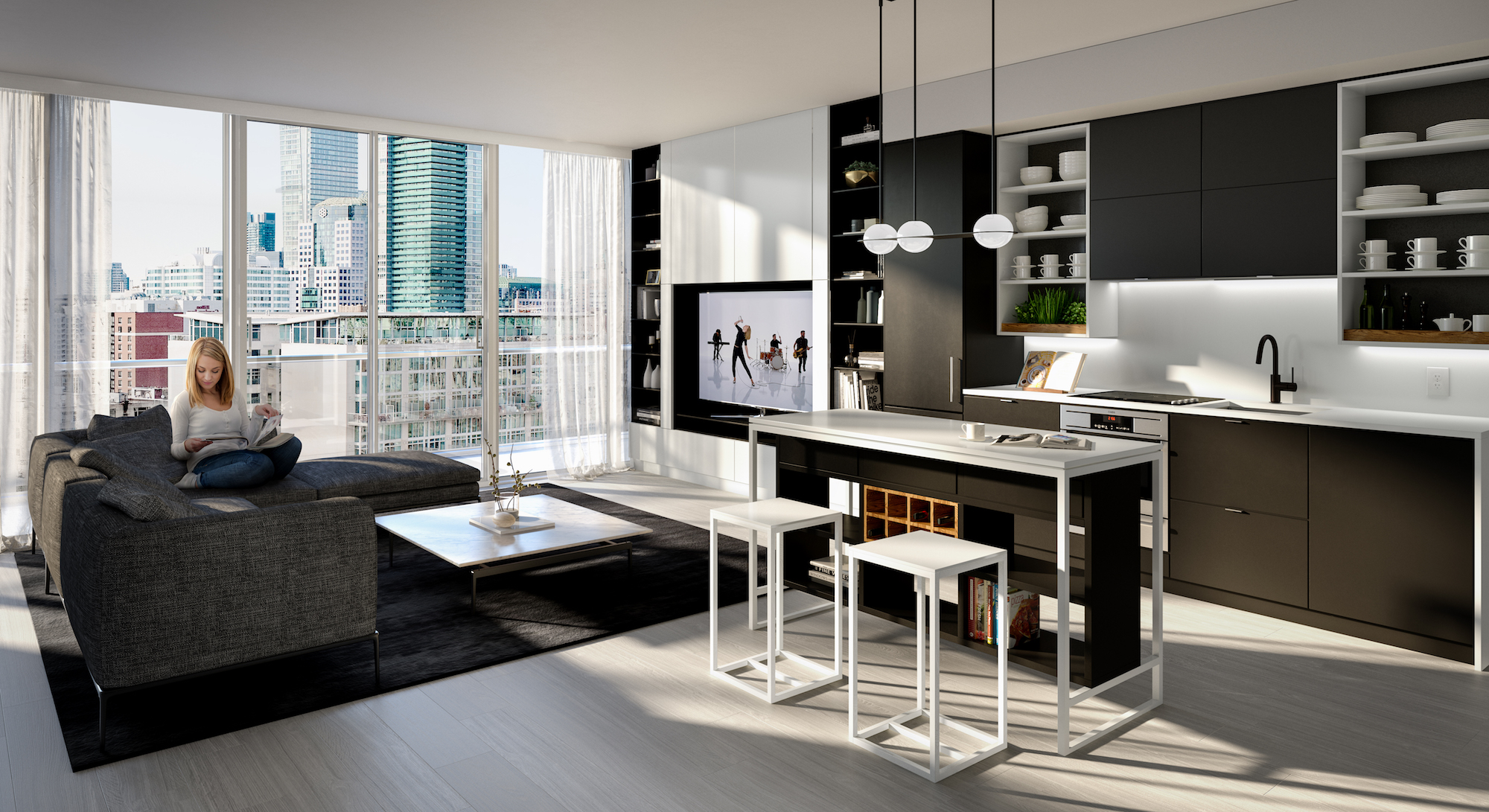
12 Jan Rock Stars
Bisha Hotel & Residences – Sexy, sensual and smart—is what happens when influencers Charles Khabouth and Alessandro Munge build out their club cred into a space that’s memorable for a drink, a night or a lifetime.
THE REIGNING KING of Toronto hospitality and the founder of one of the city’s buzziest design firms—Charles Khabouth, ceo, INK Entertainment, and Alessandro Munge, principal, Studio Munge, respectively—are masters of #eyecandy. From the edgy attitude of music venues such as Rebel (a finalist in the 2017 Gold Key Awards for Excellence in Hospitality Design) to restaurants with a more refined sense of beauty, such as Figo (a 2016 Gold Key finalist), sensory delights and high drama interiors are the duo’s stock in trade.
At first glance, Khabouth and Munge could be brand ambassadors for any of their projects. Their look—from edgy black clothes and where-did-you-find that jewelry to close-up-ready hair—is the human-scale translation of an INK locale. What’s much easier to overlook is just how much both embrace the gritty, detail-oriented and sometimes just plain frustrating process of bringing their concepts to life. Even for this dream team, tough footprints, regulatory restrictions and challenging timelines are as much in the center of their vision as the unforgettable design touches.
Case in point: Khabouth’s debut hotel, the 96-key/355-condo unit/seven rental unit Bisha Hotel & Residences in Toronto. Then again, with the hotel taking its moniker from his own childhood nickname (Khabouth’s given first name is Bechara), it’s hardly surprising that Khabouth sees himself as the target guest (and homebuyer, as he decamped as he decamped from his Munge-designed King West condo to take up residence at Bisha).
He and Munge scaled his tastes into a psychographic. “Bisha’s guests are part of a discerning vanguard— well-traveled culture seekers who possesses a quiet confidence, a sharp intellect and an effortless style,” says Khabouth. “They can be from many different backgrounds and disciplines. What makes them the perfect Bisha guest is their affinity for challenging the status quo and leaving their mark on the world.”
Trying to find a site close enough to the urban core to attract that market required the team to challenge their own status quo. In Toronto, as in many gateway cities, the plum locations have been picked off for big-ticket projects, leaving most hoteliers to find creative solutions for difficult sites. Like so many of the latest generation of lifestyle hotels (as in New York’s Mondrian Park Avenue, Chicago’s Hotel EMC2, Autograph Collection and the upcoming Virgin Hotels New York), getting the “right address” for Bisha in the city’s Entertainment District entailed squeezing all the facilities needed to create an escapist venue for those individuals into a tiny slice of real estate.
In Bisha’s case, it wasn’t just size that was a challenge. The original office building that would serve as the foundation of the hotel and residences only rose five stories—nowhere near the 44-floor tower the team envisioned. And the heritage building’s façade had to be preserved, so the street-level view would remain the same while a skyscraper rose up above it.
The first hurdle? Keeping the original frontage intact while building a tower behind it. “The heritage conservation rules meant we had to brace and move the façade during construction to preserve it,” says Brian Brown, vice president of the project’s developer, Lifetime Developments. That added millions of dollars to the budget.
Then there was the height issue. The city’s zoning only allowed for 41 floors—three stories shy of what the team wanted. Cue another wait while the city reviewed and reconsidered the zoning regulations, with delays stretching into years, not months—so long, in fact, that the team had to redo aspects of the interior design to make sure it was still timely when the hotel opened.
Even with the biggest structural roadblocks crossed, the small floorplan still called for a radical rethink of a typical hotel layout. It was a given that the tower had to deliver dazzling, varied and immersive experiences to keep guests and locals on-site and interested in this vertical neighborhood.
In Bisha’s case, that started with three F&B venues—Michelin-starred South Korean chef and former professional snowboarder Akira Back’s eponymous Japanese venue; the French Made cafe; and the modern beach house-inspired rooftop restaurant Kost—that run the culinary gamut. Mister C. does the same for drinkable treats. A 43rd-floor event space offers equally spectacular views for meetings or social events, while a state-of-the-art fitness center outfitted with sculptural equipment helps satisfy guests’ desire to look and feel good.
Because there was nowhere to go but up, Khabouth and Munge conceptualized the project in layers, almost like a modular building. With the exception of French Made, which shares the ground floor with the lobby and Mister C., each element is “stacked” one to a floor, from the second-floor Akira Back to the rooftop Kost.
Overall, Brown, Khabouth and Munge wanted to create a hybrid of residential and commercial style that allowed for indulgent, evocative public spaces and rooms with enough calm to recharge. Khabouth’s signature blend of luxe and sex appeal was a clear roadmap for the design. “But he wanted to distill all of his experience in restaurants, bars and lounges under one roof,” says Munge.
Their target guests aren’t going to be seduced with predictable style, even if it’s impeccable. These are the kind of travelers and residents to whom anything can be the wow moment, starting with a namedropping art program.
“Art curator, Grace Zeppilli, selected and securely installed close to 2,000 pieces at Bisha, which is a significant number for a 96-key hotel. Some treasured items were selected from Khabouth’s private collection,” says Munge. “In addition, together we shopped for special pieces in the markets of Paris, London and New York.”
The result is a heady blend of contemporary installations, from celebrity photographs to Damien Hirst originals to Toronto artist Jeff Goodman’s handblown glass birds suspended from the lobby ceiling to Jeff Koons’ “Balloon Venus,” which makes an unforgettable statement in the lobby.
And that’s just the beginning of the focal points at Bisha. The FF&E takes its co-starring role from the moment guests enter the lobby. Velvet walls beg to be petted. Giant knobs offer a tactile treat for guests entering or exiting a space.
Making such delicate surfaces sturdy enough to handle heavy traffic isn’t easy, despite a commercial-grade finish library and using in-house procurement at Studio Munge to streamline the process. Both Khabouth and Munge are OK with dealing with materials that are perfectly imperfect.
You could build steel and concrete interiors that would last forever, but why would you?” asks Munge. Adds Khabouth: “I like patina, just like you’d find in someone’s home.” Airbrushed perfection doesn’t interest Khabouth. He wants his guests to feel free to “live” in the spaces.
He also doesn’t believe collaboration means being a “yes man.” As proof, he delayed the restaurant opening to install chairs that swivel, for easier conversation, and to add sconces so that booths aren’t too dark to read menus and chat—neither item something Munge had insisted on.
In the private areas of the hotel, whose guest rooms include several different room types, as well as suites, the shell is quieter, but the opulence continues. Elegant armoires in place of closets have a playful secret, in the form of vividly colored interiors. Velvet seating is equal parts decadent and comfy. In the suites, multiple bathrooms allow for both a private one for the guest and one for the “guests of the guests.”
The whole formula, from lobby to guest room, clearly struck a chord with the market—most condos sold out before the grand opening. And, with the help of Loews Hotels, the team believes they can re-create that magic.
Loews was brought in by Khabouth for its operations expertise (while it did not dictate design, he says the hotelier did offer suggestions on back-of-house services). Together, they are planning to scale the brand to gateway cities worldwide, though no specifics have yet been disclosed. Anyone ready to arty on down?




